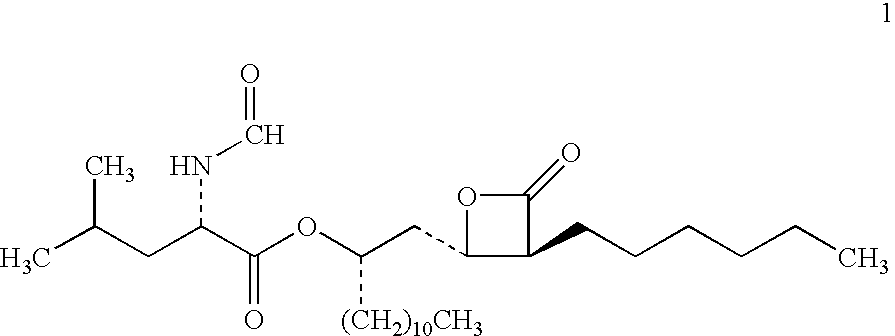Fermentation process for lipstatin and method of extracting lipstatin from a fermentation broth
a fermentation broth and lipostat technology, applied in the field of fermentation process for producing lipostat, can solve the problems of high morbidity rate and early mortality, low yield of fermentation, and small amount of feed solution
- Summary
- Abstract
- Description
- Claims
- Application Information
AI Technical Summary
Benefits of technology
Problems solved by technology
Method used
Image
Examples
example 2
[0109] The seed culture (80 ml) of Example 1 was used to inoculate on a laboratory scale. The stirred fermentor with a vessel size of 7 litres contained 4.0 litres of the main fermentation medium (F-2). Composition of the main fermentation medium included Soya bean flour 120.0 grams, glycerol 28.0 grams, cotton seed meal 4.0 grams, polypropylene glycol 1.0 gram, Soya oil 320 ml, Triton X-100 6.0 grams as an emulsifier in 4 litres. The pH of the fermentation medium was adjusted to 7.0.+-.0.1 with NaOH before sterilization. Incubation was carried out at 28.+-.2.degree. C. for 6-7 days under aerobic condition (1,500 rpm, 1 vvm).
[0110] The amount of lipstatin was 1,500-1,600 mg / l after an incubation period of 144-168 hours. The viscosity of the fermentation broth was 400-500 mPascal secundum as determined with the instrument: Anton Paar Rheolab MCI MS Z3 DIN D=10 s-1.
example 3
[0111] About 2-5 vol. % of the seed culture of Example 1 was used to inoculate a 500 ml Erlenmeyer flask which contained 50.+-.5 ml of fermentation medium (F-2). The fermentation medium (F-2) contained the following ingredients: Soya bean flour 30 grams, glycerol 7.0 grams, cotton seed meal 1.0 gram, polypropylene glycol 0.20 gram, Soya oil 80 ml, Brij 35 S 3.0 grams as an emulsifier in 1 litre tap water. The pH of the fermentation medium was adjusted to 7.0.+-.0.1 with NaOH. Sterilization was done at 121.+-.2.degree. C., 100.+-.10 kPa, for 25 minutes. Fermentation was carried out at 28.+-.2.degree. C. for 6-7 days under aerobic conditions.
[0112] The amount of lipstatin was 1,300-1,400 mg / ] after an incubation period of 144-168 hours. The viscosity of the fermentation broth was 600-700 mPascal secundum as determined with the instrument: Anton Paar Rheolab MCI MS Z3 DIN D=10 s-1.
example 4
[0113] About 2-5 vol % of the seed culture of Example 1 was used to inoculate a 500 ml Erlenmeyer flask, which contained 50.+-.5 ml of fermentation medium (F-3).The fermentation medium (F-3) contained the following ingredients: Soya bean flour 30 grams, glycerol 7.0 grams, cotton seed meal 1.0 gram, polypropylene glycol 0.20 gram, Soya oil 80 ml, Soya lecithin 12 gram as an emulsifier in 1 litre tap water. The pH of the fermentation medium was adjusted to 7.0+0.1 with NaOH. Sterilization was done at 121.+-.2.degree. C., 100.+-.10 kPa for 25 minutes. Fermentation was carried out at 28.+-.2.degree. C. for 6-7 days under aerobic conditions.
[0114] The amount of lipstatin was 1,200-1,300 mg / l after an incubation period of 144-168 hours. The viscosity of the fermentation broth was 1,600-1,700 mPascal secundum as determined with the instrument: Anton Paar Rheolab MCI MS Z3 DIN D=10 s-1.
PUM
 Login to View More
Login to View More Abstract
Description
Claims
Application Information
 Login to View More
Login to View More - R&D
- Intellectual Property
- Life Sciences
- Materials
- Tech Scout
- Unparalleled Data Quality
- Higher Quality Content
- 60% Fewer Hallucinations
Browse by: Latest US Patents, China's latest patents, Technical Efficacy Thesaurus, Application Domain, Technology Topic, Popular Technical Reports.
© 2025 PatSnap. All rights reserved.Legal|Privacy policy|Modern Slavery Act Transparency Statement|Sitemap|About US| Contact US: help@patsnap.com

